+ Open data
Open data
- Basic information
Basic information
| Entry | Database: PDB / ID: 7ctf | |||||||||||||||||||||
|---|---|---|---|---|---|---|---|---|---|---|---|---|---|---|---|---|---|---|---|---|---|---|
| Title | Human origin recognition complex 1-5 State II | |||||||||||||||||||||
 Components Components | (Origin recognition complex subunit ...) x 5 | |||||||||||||||||||||
 Keywords Keywords | REPLICATION / DNA replication initiation / Origin recognition complex (ORC) / cryo-EM / autoinhibition conformation | |||||||||||||||||||||
| Function / homology |  Function and homology information Function and homology informationpolar body extrusion after meiotic divisions / CDC6 association with the ORC:origin complex / origin recognition complex / E2F-enabled inhibition of pre-replication complex formation / nuclear origin of replication recognition complex / nuclear pre-replicative complex / inner kinetochore / DNA replication preinitiation complex / mitotic DNA replication checkpoint signaling / neural precursor cell proliferation ...polar body extrusion after meiotic divisions / CDC6 association with the ORC:origin complex / origin recognition complex / E2F-enabled inhibition of pre-replication complex formation / nuclear origin of replication recognition complex / nuclear pre-replicative complex / inner kinetochore / DNA replication preinitiation complex / mitotic DNA replication checkpoint signaling / neural precursor cell proliferation / G1/S-Specific Transcription / regulation of DNA replication / DNA replication origin binding / protein polymerization / DNA replication initiation / Activation of the pre-replicative complex / Activation of ATR in response to replication stress / glial cell proliferation / heterochromatin / Assembly of the ORC complex at the origin of replication / Assembly of the pre-replicative complex / Orc1 removal from chromatin / DNA replication / chromosome, telomeric region / nuclear body / nucleotide binding / chromatin binding / centrosome / chromatin / nucleolus / negative regulation of transcription by RNA polymerase II / ATP hydrolysis activity / DNA binding / nucleoplasm / ATP binding / metal ion binding / nucleus / membrane / cytosol Similarity search - Function | |||||||||||||||||||||
| Biological species |  Homo sapiens (human) Homo sapiens (human) | |||||||||||||||||||||
| Method | ELECTRON MICROSCOPY / single particle reconstruction / cryo EM / Resolution: 4.8 Å | |||||||||||||||||||||
 Authors Authors | Cheng, J. / Li, N. / Wang, X. / Hu, J. / Zhai, Y. / Gao, N. | |||||||||||||||||||||
| Funding support |  China, 1items China, 1items
| |||||||||||||||||||||
 Citation Citation |  Journal: Cell Discov / Year: 2020 Journal: Cell Discov / Year: 2020Title: Structural insight into the assembly and conformational activation of human origin recognition complex. Authors: Jiaxuan Cheng / Ningning Li / Xiaohan Wang / Jiazhi Hu / Yuanliang Zhai / Ning Gao /  Abstract: The function of the origin recognition complex (ORC) in DNA replication is highly conserved in recognizing and marking the initiation sites. The detailed molecular mechanisms by which human ORC is ...The function of the origin recognition complex (ORC) in DNA replication is highly conserved in recognizing and marking the initiation sites. The detailed molecular mechanisms by which human ORC is reconfigured into a state competent for origin association remain largely unknown. Here, we present structural characterizations of human ORC1-5 and ORC2-5 assemblies. ORC2-5 exhibits a tightly autoinhibited conformation with the winged-helix domain of ORC2 completely blocking the central DNA-binding channel. The binding of ORC1 partially relieves the autoinhibitory effect of ORC2-5 through remodeling ORC2-WHD, which makes ORC2-WHD away from the central channel creating a still autoinhibited but more dynamic structure. In particular, the AAA+ domain of ORC1 is highly flexible to sample a variety of conformations from inactive to potentially active states. These results provide insights into the detailed mechanisms regulating the autoinhibition of human ORC and its subsequent activation for DNA binding. | |||||||||||||||||||||
| History |
|
- Structure visualization
Structure visualization
| Movie |
 Movie viewer Movie viewer |
|---|---|
| Structure viewer | Molecule:  Molmil Molmil Jmol/JSmol Jmol/JSmol |
- Downloads & links
Downloads & links
- Download
Download
| PDBx/mmCIF format |  7ctf.cif.gz 7ctf.cif.gz | 355.9 KB | Display |  PDBx/mmCIF format PDBx/mmCIF format |
|---|---|---|---|---|
| PDB format |  pdb7ctf.ent.gz pdb7ctf.ent.gz | 270.3 KB | Display |  PDB format PDB format |
| PDBx/mmJSON format |  7ctf.json.gz 7ctf.json.gz | Tree view |  PDBx/mmJSON format PDBx/mmJSON format | |
| Others |  Other downloads Other downloads |
-Validation report
| Summary document |  7ctf_validation.pdf.gz 7ctf_validation.pdf.gz | 920.5 KB | Display |  wwPDB validaton report wwPDB validaton report |
|---|---|---|---|---|
| Full document |  7ctf_full_validation.pdf.gz 7ctf_full_validation.pdf.gz | 948.8 KB | Display | |
| Data in XML |  7ctf_validation.xml.gz 7ctf_validation.xml.gz | 50.4 KB | Display | |
| Data in CIF |  7ctf_validation.cif.gz 7ctf_validation.cif.gz | 77.8 KB | Display | |
| Arichive directory |  https://data.pdbj.org/pub/pdb/validation_reports/ct/7ctf https://data.pdbj.org/pub/pdb/validation_reports/ct/7ctf ftp://data.pdbj.org/pub/pdb/validation_reports/ct/7ctf ftp://data.pdbj.org/pub/pdb/validation_reports/ct/7ctf | HTTPS FTP |
-Related structure data
| Related structure data |  30463MC  7cteC  7ctgC M: map data used to model this data C: citing same article ( |
|---|---|
| Similar structure data |
- Links
Links
- Assembly
Assembly
| Deposited unit | 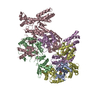
|
|---|---|
| 1 |
|
- Components
Components
-Origin recognition complex subunit ... , 5 types, 5 molecules ABCDE
| #1: Protein | Mass: 97499.867 Da / Num. of mol.: 1 Source method: isolated from a genetically manipulated source Source: (gene. exp.)  Homo sapiens (human) / Gene: ORC1, ORC1L, PARC1 / Production host: Homo sapiens (human) / Gene: ORC1, ORC1L, PARC1 / Production host:  |
|---|---|
| #2: Protein | Mass: 66063.375 Da / Num. of mol.: 1 Source method: isolated from a genetically manipulated source Source: (gene. exp.)  Homo sapiens (human) / Gene: ORC2, ORC2L / Production host: Homo sapiens (human) / Gene: ORC2, ORC2L / Production host:  |
| #3: Protein | Mass: 82365.055 Da / Num. of mol.: 1 Source method: isolated from a genetically manipulated source Source: (gene. exp.)  Homo sapiens (human) / Gene: ORC3, LATHEO, ORC3L / Production host: Homo sapiens (human) / Gene: ORC3, LATHEO, ORC3L / Production host:  |
| #4: Protein | Mass: 50443.266 Da / Num. of mol.: 1 Source method: isolated from a genetically manipulated source Source: (gene. exp.)  Homo sapiens (human) / Gene: ORC4, ORC4L / Production host: Homo sapiens (human) / Gene: ORC4, ORC4L / Production host:  |
| #5: Protein | Mass: 50349.934 Da / Num. of mol.: 1 Source method: isolated from a genetically manipulated source Source: (gene. exp.)  Homo sapiens (human) / Gene: ORC5, ORC5L / Production host: Homo sapiens (human) / Gene: ORC5, ORC5L / Production host:  |
-Non-polymers , 1 types, 2 molecules 
| #6: Chemical |
|---|
-Details
| Has ligand of interest | Y |
|---|---|
| Has protein modification | N |
-Experimental details
-Experiment
| Experiment | Method: ELECTRON MICROSCOPY |
|---|---|
| EM experiment | Aggregation state: PARTICLE / 3D reconstruction method: single particle reconstruction |
- Sample preparation
Sample preparation
| Component | Name: Human Origin Recognition Complex 1-5 / Type: COMPLEX / Entity ID: #1-#3 / Source: RECOMBINANT |
|---|---|
| Source (natural) | Organism:  Homo sapiens (human) Homo sapiens (human) |
| Source (recombinant) | Organism:  |
| Buffer solution | pH: 7.6 |
| Specimen | Embedding applied: NO / Shadowing applied: NO / Staining applied: NO / Vitrification applied: YES |
| Vitrification | Cryogen name: ETHANE |
- Electron microscopy imaging
Electron microscopy imaging
| Experimental equipment |  Model: Titan Krios / Image courtesy: FEI Company |
|---|---|
| Microscopy | Model: FEI TITAN KRIOS |
| Electron gun | Electron source:  FIELD EMISSION GUN / Accelerating voltage: 300 kV / Illumination mode: FLOOD BEAM FIELD EMISSION GUN / Accelerating voltage: 300 kV / Illumination mode: FLOOD BEAM |
| Electron lens | Mode: BRIGHT FIELD |
| Image recording | Electron dose: 65 e/Å2 / Detector mode: SUPER-RESOLUTION / Film or detector model: GATAN K2 SUMMIT (4k x 4k) |
- Processing
Processing
| Software | Name: PHENIX / Version: dev_3689: / Classification: refinement | ||||||||||||||||||||||||
|---|---|---|---|---|---|---|---|---|---|---|---|---|---|---|---|---|---|---|---|---|---|---|---|---|---|
| EM software | Name: PHENIX / Category: model refinement | ||||||||||||||||||||||||
| CTF correction | Type: PHASE FLIPPING AND AMPLITUDE CORRECTION | ||||||||||||||||||||||||
| Symmetry | Point symmetry: C1 (asymmetric) | ||||||||||||||||||||||||
| 3D reconstruction | Resolution: 4.8 Å / Resolution method: FSC 0.143 CUT-OFF / Num. of particles: 627000 / Symmetry type: POINT | ||||||||||||||||||||||||
| Refine LS restraints |
|
 Movie
Movie Controller
Controller






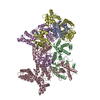
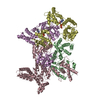
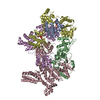
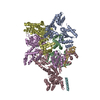
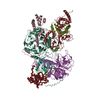
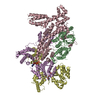
 PDBj
PDBj





